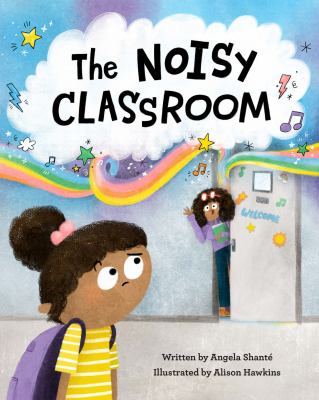 I recently came across a fantastic picture book called The Noisy Classroom by Angela Shantae, illustrated by Alison Hawkins. In it, a young student, is worried about the “weird” goings on of the 3rd grade classroom run by the noisy and odd Ms. Johnson. When the student finds out that next year, she will be in that same classroom with all the noise and weird behavior, she’s flabbergasted. However, it all ends up being a matter of perspective, as it often does, when she discovers all the wonderful things that that noisy classroom has in store for her: an enriching learning environment full of games and creativity.
I recently came across a fantastic picture book called The Noisy Classroom by Angela Shantae, illustrated by Alison Hawkins. In it, a young student, is worried about the “weird” goings on of the 3rd grade classroom run by the noisy and odd Ms. Johnson. When the student finds out that next year, she will be in that same classroom with all the noise and weird behavior, she’s flabbergasted. However, it all ends up being a matter of perspective, as it often does, when she discovers all the wonderful things that that noisy classroom has in store for her: an enriching learning environment full of games and creativity.
This story got me thinking about my old elementary school, where the higher grades (4th and 5th) were on the complete opposite side of the building than the lower grades. It was very odd indeed when we had to move up to the other part of the building that seemed too different from what I was used to. I was not familiar with the wide, decorated hallways or the “grown up” desks in the classroom at all! But once I got there and embraced the change, I was happy to be there and felt very mature in my new “higher grades” status.
Have you ever felt like that?
Once I started thinking about that 4th grade feeling, I chased a little rabbit of a thought right into a hole. It went like this: the book led me to think about my old school building which got me thinking about a show I used to watch called Road to Avonlea, and a book I read: Anne of Green Gables. Suddenly, I found myself in the magical land of databases, particularly Daily Life through History to look for facts about old schoolhouses. (A natural progression, of course.)
Did you know?
School used to look a lot different! So different in fact, there were no hallways separating the lower and higher grade, there were no hallways at all in some cases! What some schools used to be: one big room schoolhouses that had all the grades in one room learning at the same time from the same teacher. According to Southern Education in Antebellum America, “books and paper were expensive” so, “[s]tudents were often required to take oral tests. They memorized mandatory lessons and recited answers.” (Baker 2021) That is not how school functions these days, for sure, but talk about a noisy classroom!
Want to find out more? Check out this article, “Schoolhouses in America: 19th Century” in the Daily Life through History database and check out this picture of a schoolhouse in Maryland!
Remember, you can always chase the rabbit down the hole to brand new discoveries with databases! (Scroll all the way down for the databases)
- Julia Cantrell, Youth Librarian, Peggy Helmerich Library
Works Cited:
Baker, Jane Piland. "Southern Education in Antebellum America." Daily Life through History, ABC-CLIO, 2021, dailylife.abc-clio.com/Search/Display/2197089. Accessed 19 Aug. 2021.
Volo, James M. and Dorothy Denneen Volo. "Schoolhouses in America: 19th Century." Daily Life through History, ABC-CLIO, 2021, dailylife.abc-clio.com/Search/Display/1334755. Accessed 19 Aug. 2021.
"Maryland Schoolhouse and Students, Ca. 1900." Daily Life through History, ABC-CLIO, 2021, dailylife.abc-clio.com/Search/Display/1736717. Accessed 19 Aug. 2021.